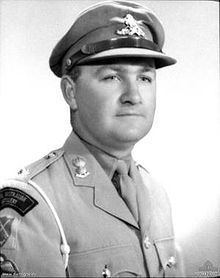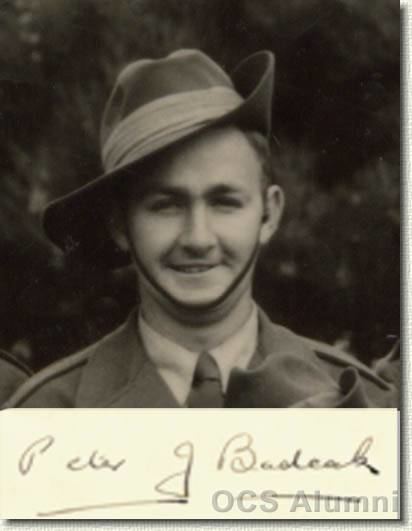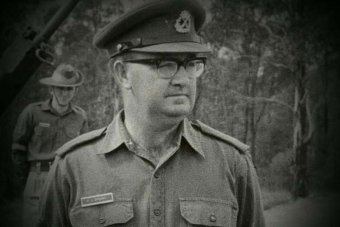Rank Major Allegiance Australia Name Peter Badcoe | Role Armed force officer Years of service 1952–1967 | |
 | ||
Born 11 January 1934Malvern, South Australia, Australia ( 1934-01-11 ) Buried at Terendak Military Cemetery Died April 7, 1967, Thua Thien-Hue Province, Vietnam Education Glenunga International High School Place of burial Terendak Military Cemetery Similar People Kevin Wheatley, Ray Simpson, Keith Payne | ||
Nickname(s) "The Galloping Major" | ||
3RAR 1971 - Vung Tau
Peter John Badcoe, VC (11 January 1934 – 7 April 1967) was an Australian recipient of the Victoria Cross, the highest award for gallantry "in the face of the enemy" that can be awarded to British and Commonwealth forces.
Contents

Early life and career

Badcoe was born as Peter John Badcock on 11 January 1934 in the Adelaide suburb of Malvern, South Australia, to Leslie Allen Badcock, a public servant, and his wife Gladys Mary Ann May (née Overton). He was educated at Adelaide Technical High School, before gaining employment as a clerk with the South Australian Public Service. Despite his father's opposition to the prospect, Badcock held ambitions to join the Australian Army; he did so in April 1952. He was called up for National Service (4/702401) and served for a period of seven weeks with the 16th National Service Training Battalion, prior to receiving acceptance as an officer cadet at the Officer Cadet School, Portsea on 15 June that year. Following six months of training, Badcock graduated nineteenth in his course out of forty-nine cadets on 13 December and was commissioned as a second lieutenant into the Royal Australian Artillery. In his assessment of Badcock, Portsea's commandant noted that he was a "very keen and sound student" and would "make a capable officer".

On 26 May 1956, he married Denise MacMahon in the Methodist Church, Manly, Sydney, and in 1961 he changed his surname to Badcoe. He also played hockey for South Australia while at school and played a fife in the school band. His first car was a little red MG.

He was survived by his wife Denise and three daughters: Carey, Kim and Susanne. He also had a sister, Thelma. His grandchildren include Connor, Nicky, Peter, Josie, Michelle, Lucy and D'Arcy.
Vietnam War
He was 33 years old, and a major in the Australian Army Training Team Vietnam during the Vietnam War when the following deed took place for which he was awarded the Victoria Cross.
On 23 February 1967, in Hương Trà, Vietnam, Major Badcoe rescued, under heavy fire, a United States Medical Adviser. On 7 March, he led his company in an attack and turned what seemed to be certain defeat into a victory. Again, on 7 April, he attempted to lead his company against more powerful opposition. This final act of bravery resulted in his death. The main hall at Officer Cadet School, Portsea was named in his honour, as is the main lecture theatre in the Military Instruction Block at the Royal Military College, Duntroon.
Legacy
For his "three acts of heroism" and "outstanding leadership" between February and April 1967, Badcoe was posthumously decorated with the Victoria Cross. The full citation for the award appeared in a supplement of the London Gazette on 17 October 1967, reading in part:
The QUEEN has been graciously pleased on the advice of Her Majesty's Australian Ministers to approve the posthumous award of the VICTORIA CROSS to:
Major PETER JOHN BADCOE (41400), Royal Australian Infantry Corps.
[...]
On 23rd February 1967 he was acting as an Advisor to a Regional Force Company in support of a Sector operation in Phu Thu District. He monitored a radio transmission which stated that the Subsector Adviser, a United States Army Officer, had been killed and that his body was within 50 metres of an enemy machine gun position; further, the United States Medical Adviser had been wounded and was in immediate danger from the enemy. Major BADCOE with complete disregard for his own safety moved alone across 600 metres of fire-swept ground and reached the wounded Adviser, attended to him and ensured his future safety. He then organised a force of one platoon and led them towards the enemy post. His personal leadership, words of encouragement, and actions in the face of hostile enemy fire forced the platoon to successfully assault the enemy position and capture it, where he personally killed the machine gunners directly in front of him. He then picked up the body of the dead officer and ran back to the Command post over open ground still covered by enemy fire.
On 7th March 1967, at approximately 0645 hours, the Sector Reaction Company was deployed to Quang Dien Subsector to counter an attack by the Viet Cong on the Headquarters. Major BADCOE left the Command group after their vehicle broke down and a United States Officer was killed; he joined the Company Headquarters and personally led the company in an attack over open terrain to assault and capture a heavily defended enemy position. In the face of certain death and heavy losses his personal courage and leadership turned certain defeat into victory and prevented the enemy from capturing the District Headquarters.
On 7th April 1967, on an operation in Huong Tra District, Major BADCOE was with the 1st A.R.V.N. Division Reaction Company and some armoured personnel carriers. During the move forward to an objective the company came under heavy small arms fire and withdrew to a cemetery for cover, this left Major BADCOE and his radio operator about 50 metres in front of the leading elements, under heavy mortar fire. Seeing this withdrawal, Major BADCOE ran back to them, moved amongst them and by encouragement and example got them moving forward again. He then set out in front of the company to lead them on; the company stopped again under heavy fire but Major BADCOE continued on to cover and prepared to throw grenades, when he rose to throw, his radio operator pulled him down as heavy small arms fire was being brought to bear on them; he later got up again to throw a grenade and was hit and killed by a burst of machine gun fire. Soon after, friendly artillery fire was called in and the position was assaulted and captured.
Major BADCOE'S conspicuous gallantry and leadership on all these occasions was an inspiration to all, each action, ultimately, was successful, due entirely to his efforts, the final one ending in his death. His valour and leadership were in the highest traditions of the military profession and the Australian Regular Army.
Badcoe's medal group and personal memoirs were offered for sale by auction in Sydney on 20 May 2008. Estimated at between A$400,000–600,000, the group eventually sold for A$488,000 to Kerry Stokes in collaboration with the South Australian State Government. Badcoe's Victoria Cross and associated medals were displayed at the South Australian Museum in Adelaide, prior to being toured to regional South Australia in 2009, before being displayed permanently at the Australian War Memorial in Canberra.
Honours and awards
For his services in Vietnam, in addition to the Victoria Cross, Peter Badcoe was also decorated by the United States of America with the Silver Star with oak leaf cluster for valor (sic), the Purple Heart after being wounded, and the Air Medal. The South Vietnamese awarded him the Vietnam Gallantry Cross with Gold Star and Silver Star, and the Wound Medal.
